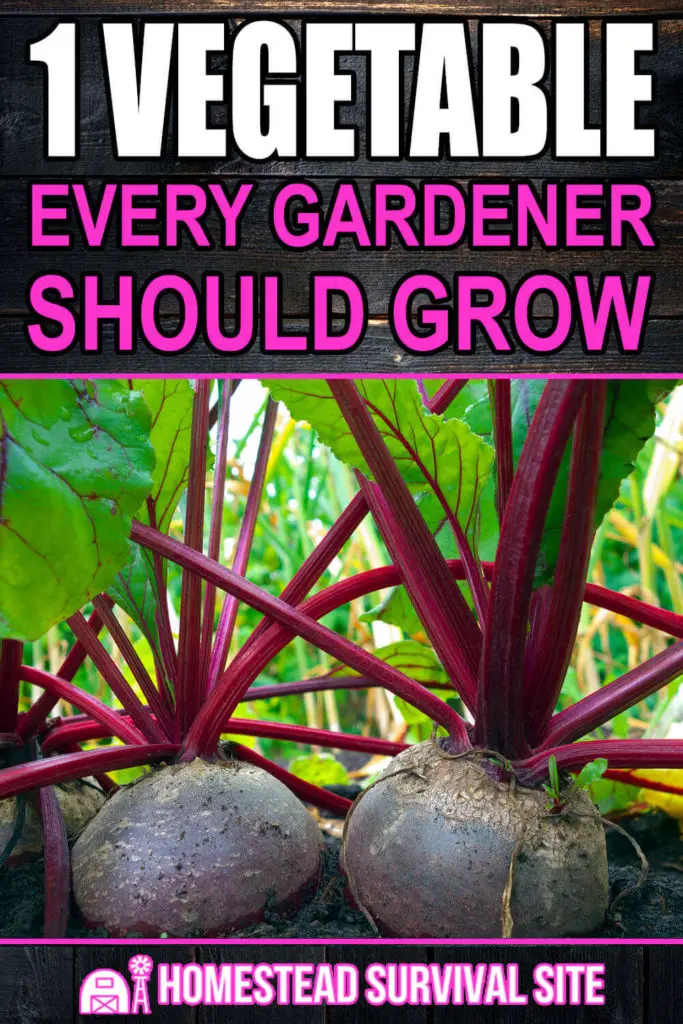Estimated reading time: 11 minutes
Beets, Beets, the Magical Roo
When it comes to the vegetable garden, there is no shortage of nutritious and beneficial plants to grow through peak summer season. However, best utilizing your space and maximizing growing time means that you must include the wise choice of growing beets! This is just my opinion, but beets are my favorite vegetable to grow for a variety of reasons.
Beets are a crop with a quick turn-around, easy to grow from seed, and ready to harvest after a short wait. Because beets thrive in cooler weather, they are a perfect plant for you to grow prior to your prime planting time of summer sun and heat. You can plant early in spring for a first harvest, and you can plant beets again at the end of your harvest season for the summer garden, taking advantage of space for a fall crop.
In addition to the ease of growing beets, this plant is nutritionally rich. You can eat the stems as well as the roots and have great benefits from both. Beets are a source of a variety of vitamins and dense nutrition, and best of all, beets having healing properties.
Want to save this post for later? Click Here to Pin It On Pinterest!
Growing Beets
As a simple crop to grow from seed, beets are perfect for getting you back into the planting season after a long winter. Beets do not take long to mature, with most averaging about 7-8 weeks from planting.
Beets will grow in most climates. Too hot of heat and sun has a negative effect on beets though, so stick to the cooler months of your growing season. Ideal weather for a beet crop is when temperatures average to 60-70 degrees during the day and as low as 50 degrees in the evening. Your soil should be loose and workable and have at least a 40-degree read on soil temperature.
In terms of selecting your spot, beets can be planted in partial shade to full sun. Beets prefer sandy soil in spring which helps hold heat for those early frosts. In fall, heavier soil works best as long it is loose enough to be workable without clay. Because this is a root vegetable, make sure there are no competing tree or bush roots and that the ground is free of large rocks and sticks.
Beets need boron in the soil, otherwise they may be prone to disease. If you’re uncertain, or have had bad results in the past, there are ways to test your soil. It is helpful to add compost to your garden bed, and a 10-10-10 fertilizer.
Sow beets 1 inch deep, about 2-3 inches apart. Each seed will sprout a few beets, so as growing begins you may need to thin out the growth. Like any root vegetable if you pull one, you’re at risk of disrupting the plants that you wish to keep. Instead, just trim the greens to the ground of the beets you want to eliminate. The greens you snip are edible, so it is not a waste!
If at any time if during beet season you are worried that temperatures may get a little warm for optimal growth (anything over 75 degrees), add some light-colored mulch to reflect heat off the soil. If the heat peaks around 80 degrees where you live, then you can continually plant beets through the whole summer season.
Nutritional Benefits of Beets
Beet root is most known as the edible and nutritious part of the beet, but you can eat the entire plant with great healthy benefits. Low in calories but high in vitamins and dense nutrition, beets almost sound too good to be true.
One cup of beet root is only 43 calories but carries solid nutrition with it. Beet greens are less commonly added to the diet, which is a mistake, as they are packed with vitamins and should be treated with the same importance as the root.

Beets are High in Several Vitamins
Vitamin C: Not only does vitamin C help with iron absorption, but it also offers a great immune system boost. A serving of roasted beet root has over 3 mg of vitamin C. Eating beets raw, roasted, or steamed is the best way to retain the most of this vitamin. Because vitamin C is water soluble, you lose some of the vitamin if you choose to boil the beets. Add 100g of beet greens and the vitamin C content jumps to 30mg!
Fiber: Fiber is necessary for our digestive systems, and beets are a great natural source. 1 cup of cooked beets has 3.2 grams of fiber. Natural fiber sources help make a healthy gut.
Folate: In pregnancy, making sure that your diet is full of folate is especially important to avoid issues with spinal cord development. Though prenatal vitamins include folate, it is always best to get the most of your nutritional needs through the foods that you eat. Beets are a great source of the B vitamin folate.
Vitamin A: Vitamin A is an important vitamin that supports reproductive health, eyesight, the immune system and offers support to most of your vital organs. 1 cup of beet greens offers 100% of your daily need of this vitamin.
Vitamin K: This vitamin helps your blood health and ability to coagulate blood. Beets greens are a healthy source.
Beet greens are also a source of B vitamins niacin, thiamin, and riboflavin.
Beets Are a Great Source of Essential Minerals
Iron: Everyone needs daily iron to maintain blood health and to prevent anemia. With a balanced diet, it can be easy to hit your daily need. Though many animal products are a great source, beets are among the many vegetables that are a natural resource of the mineral and the vitamin C, which helps iron absorption.
Both beets and beet greens are a natural source of iron. One cup of raw beets has 1.1 mg of iron, with an increase to 1.4 mg for a cup of cooked beets. Once cup of raw beet greens has 1 mg of iron, 1 cup of cooked greens has 2.7 mg of iron. One cup of beet juice has 1.44 mg of iron. Tip: toss some sliced beets and greens in a salad with mandarin oranges or lemon juice to increase the vitamin C, which will help your iron absorption.
Potassium: Potassium is an essential mineral that our body needs every day. Potassium is known for its muscle support (think cramps), but it also boosts energy, supports the heart and healthy blood pressure, and protects cells. Only 1309 mgs (just over a gram) of beet greens has 28% of your daily potassium needs.
Manganese: This mineral does a lot for our bodies from helping us metabolize amino acids and glucose, helping with bone formation, and even acting as a vasodilator helping blood move through the body. Manganese helps the body absorb calcium. 1 cup of beets has about 25% of the daily need.
Beet greens are also a source of calcium, magnesium, phosphorous, and zinc.
Healing Properties of Beets
On top of beets being easy to grow and full of vitamin-rich nutrition, they also have a surprisingly high list of health benefits that offer healing.
1. Lowers Blood Pressure
There have been studies that have proven that beets can reduce blood pressure. In the studies, participants drank beet juice and noticed a healthy decline of high blood pressure. The lowered blood pressure was maintained for 24 hours post beet juice, with a peak of the effect around 3-4 hours after consumption.
This remedy works due to the nitrates found within beet root. The body converts the nitrates to nitric oxide, which naturally occurs in the body, but this boost helps support health. Blood pressure is positively affected as the nitric oxide dilates blood vessels making it easier for the heart to pump blood.
Though the participants in this study drank beet juice, beets in all forms are a source of nitrates. It has been believed in the past that nitrates cause cancer, but studies have since proven that naturally occurring nitrates are not the risk for this concern.
This study shows how nitrates, especially those with vitamin C (which also naturally occurs in beets), remains as a helpful component to our bodies whereas nitrites (a common additive in preserved meats) can be carcinogenic.

2. Lower Risk of Heart Disease
The nitrates, folate, and betaine all have a role in heart health. Nitrates improve blood flow through the body and to the heart. Folate and betaine help lower high levels of homocysteine in the blood. An increased level of that amino acid risks damaging the heart and arteries through inflammation.
3. Lower Glucose in the Blood
Beets are high in soluble fiber which has been proven to lower glucose in the blood stream.
4. Athletic Performance Enhancer and Recovery Support
Nitric oxide, from the natural occurring nitrates within beats, aids in muscle repair and development. It also helps increase blood flow to the brain which naturally improves athletic performance. That increased blood flow through the body also improves oxygen-use efficiency. Because of these properties, beets in the form of beet powder can serve as a natural pre-workout.
5. Anti-Inflammatory
Betalains acts as a natural anti-inflammatory.
Risk: Beets are high in oxalates which may affect you if you’re prone to kidney stones. If you have had kidney stones, enjoy beets in moderation.
Using Beets From Cooking, Canning, and Juicing
Beets are commonly overlooked as a part of a regular diet, likely because of the strong earthy flavor that some compare to tasting like dirt. For some it may seem hard to imagine that you can learn to not only love but crave the flavor of beets. Most tastes can be acquired, and learning how to work with beets can help you find the way that you can enjoy them to make it a sustainable part of your diet.
Eating raw beets is the best way to get the most nutritional value out of them, but the benefit of enjoying them in any way is worth experimenting to find the way that you prefer to enjoy them. You can also incorporate them a few different ways.
Raw
Raw beets tend to have a sweeter, crisp flavor and there’s a lot of ways to use them. Shaving them, or shredding them is a great salad topper, or salad star. Add a citrus vinaigrette to up that vitamin C to absorb your natural iron.
Roasted
- Preheat your oven to 425 degrees.
- Cut off your stems and leaves, but keep them for another use.
- Wash your beets thoroughly.
- Set your whole beets on a piece of foil and coat in your favorites cooking oil. This will help the beets from drying out as they roast.
- Wrap the beets in the foil and put them in the oven.
- The beets are done when they are tender. Large beets will take about 45 minutes. If you are working with small beets, you can start checking after 25 minutes.
Once they are tender, let the beets cool enough to be handled. While they are warm you can easily remove the outer peel by rubbing or with a utensil.
Roasted beets are great on a salad with a fragrant cheese and seasonal fruit. Roasted beets with other root vegetables are also a very natural combination.
Canning
Canning beets is a great way to keep and preserve any of your harvest leftover. To use your canned beets later simply eat them raw, add them to salads, blend them in dips like hummus, or add to baked items like falafel or homemade vegetarian burger patties.
Juicing
Juicing beets is as simple as it gets. Though you can peel beets outer skin before you juice, there are a lot of nutrients in that top layer.
Instead, simply scrub the outer layer and slice the beets to fit your juicer. Do not throw out the steams and leaves. Because of the bright pigment of beets, you may want to prepare for any splashes or spills.
Once you have your juice, enjoy it on its own or use as an additive to recipes like soups.
An introductory way to enjoy beet juice is to add it to a smoothie. This cuts back on the intensity of the earthy flavor but doesn’t hide it completely.
For an easy smoothie recipe, try this purple goodness:
- ½ banana
- 1 cup of blueberries
- 1 cup of beet juice
- 1 scoop of vanilla protein powder
- ¼ cup Greek vanilla yogurt or vanilla kefir
- A dash of cinnamon
Beet Greens
Beet greens should always be considered as an important, edible part of this plant. The green can be eaten raw in a salad or as a chopped garnish, sauteed, braised, and juiced.
Like this post? Don't Forget to Pin It On Pinterest!










Picketed beets are the most tasty.